Related Research Articles
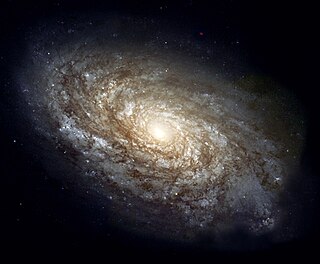
A galaxy is a system of stars, stellar remnants, interstellar gas, dust, and dark matter bound together by gravity. The word is derived from the Greek galaxias (γαλαξίας), literally 'milky', a reference to the Milky Way galaxy that contains the Solar System. Galaxies, averaging an estimated 100 million stars, range in size from dwarfs with less than a thousand stars, to the largest galaxies known – supergiants with one hundred trillion stars, each orbiting its galaxy's center of mass. Most of the mass in a typical galaxy is in the form of dark matter, with only a few percent of that mass visible in the form of stars and nebulae. Supermassive black holes are a common feature at the centres of galaxies.

The Orion Nebula is a diffuse nebula situated in the Milky Way, being south of Orion's Belt in the constellation of Orion,[b] and is known as the middle "star" in the "sword" of Orion. It is one of the brightest nebulae and is visible to the naked eye in the night sky with an apparent magnitude of 4.0. It is 1,344 ± 20 light-years (412.1 ± 6.1 pc) away and is the closest region of massive star formation to Earth. The M42 nebula is estimated to be 25 light-years across. It has a mass of about 2,000 times that of the Sun. Older texts frequently refer to the Orion Nebula as the Great Nebula in Orion or the Great Orion Nebula.

The Rosette Nebula is an H II region located near one end of a giant molecular cloud in the Monoceros region of the Milky Way Galaxy. The open cluster NGC 2244 is closely associated with the nebulosity, the stars of the cluster having been formed from the nebula's matter.
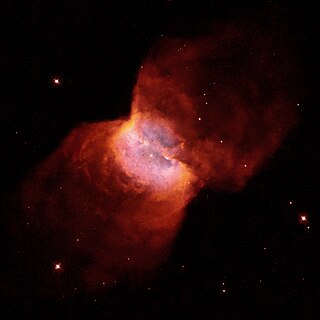
NGC 2346 is a planetary nebula near the celestial equator in the constellation of Monoceros, less than a degree to the ESE of Delta Monocerotis. It is informally known as the Butterfly Nebula. The nebula is bright and conspicuous with a visual magnitude of 9.6, and has been extensively studied. Among its most remarkable characteristics is its unusually cool central star, which is a spectroscopic binary, and its unusual shape.
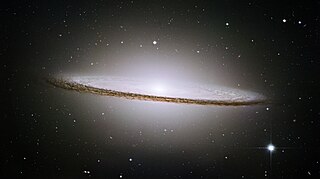
The Sombrero Galaxy is a peculiar galaxy of unclear classification in the constellation borders of Virgo and Corvus, being about 9.55 megaparsecs from the Milky Way galaxy. It is a member of the Virgo II Groups, a series of galaxies and galaxy clusters strung out from the southern edge of the Virgo Supercluster. It has an isophotal diameter of approximately 29.09 to 32.32 kiloparsecs, making it slightly bigger in size than the Milky Way.

Messier 77 (M77), also known as NGC 1068 or the Squid Galaxy, is a barred spiral galaxy in the constellation Cetus. It is about 47 million light-years (14 Mpc) away from Earth, and was discovered by Pierre Méchain in 1780, who originally described it as a nebula. Méchain then communicated his discovery to Charles Messier, who subsequently listed the object in his catalog. Both Messier and William Herschel described this galaxy as a star cluster. Today, however, the object is known to be a galaxy. It is one of the brightest Seyfert galaxies visible from Earth and has a D25 isophotal diameter of about 27.70 kiloparsecs (90,000 light-years).
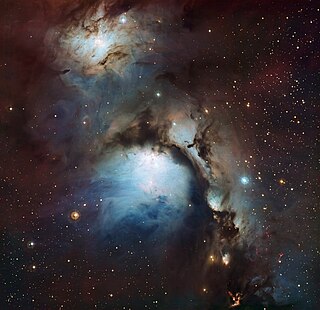
Messier 78 or M78, also known as NGC 2068, is a reflection nebula in the constellation Orion. It was discovered by Pierre Méchain in 1780 and included by Charles Messier in his catalog of comet-like objects that same year.

Herbig–Haro (HH) objects are bright patches of nebulosity associated with newborn stars. They are formed when narrow jets of partially ionised gas ejected by stars collide with nearby clouds of gas and dust at several hundred kilometers per second. Herbig–Haro objects are commonly found in star-forming regions, and several are often seen around a single star, aligned with its rotational axis. Most of them lie within about one parsec of the source, although some have been observed several parsecs away. HH objects are transient phenomena that last around a few tens of thousands of years. They can change visibly over timescales of a few years as they move rapidly away from their parent star into the gas clouds of interstellar space. Hubble Space Telescope observations have revealed the complex evolution of HH objects over the period of a few years, as parts of the nebula fade while others brighten as they collide with the clumpy material of the interstellar medium.

The Orion molecular cloud complex is a star-forming region with stellar ages ranging up to 12 Myr. Two giant molecular clouds are a part of it, Orion A and Orion B. The stars currently forming within the complex are located within these clouds. A number of other somewhat older stars no longer associated with the molecular gas are also part of the complex, most notably the Orion's Belt, as well as the dispersed population north of it. Near the head of Orion there is also a population of young stars that is centered on Meissa. The complex is between 1 000 and 1 400 light-years away, and hundreds of light-years across.

NGC 514 is a low-luminosity, intermediate spiral galaxy in the equatorial constellation of Pisces, located at a distance of approximately 83 million light-years from the Milky Way. It was discovered on 16 October 1784 by astronomer William Herschel. The general form of the galaxy is specified by its morphological classification of SAB(rs)c, which indicates it has a weak bar system at the core (SAB), an incomplete ring formation around the bar (rs), and somewhat loosely-wound spiral arms (c). This galaxy has an H II nucleus with an extended region that displays weak emission lines in the optical range, but not in the near infrared. The suspected supermassive black hole at the core has an estimated mass of 3.2×106 M☉.

The Flame Nebula, designated as NGC 2024 and Sh2-277, is an emission nebula in the constellation Orion. It is about 1350 light-years away. At that distance, the Flame Nebula lies within the Orion B cloud of the larger Orion Molecular Cloud Complex.

NGC 2023 is an emission and reflection nebula in the equatorial constellation of Orion. It was discovered by the German-born astronomer William Herschel on 6 January 1785. This reflection nebula is one of the largest in the sky, with a size of 10 × 10 arcminutes. It is located at a distance of 1,300 ly (400 pc) from the Sun, and is positioned ~15′ to the northeast of the Horsehead Nebula.

NGC 4194, the Medusa merger, is a galaxy merger in the constellation Ursa Major about 128 million light-years (39.1 Mpc) away. It was discovered on April 2, 1791 by German-British astronomer William Herschel. Due to its disturbed appearance, it is object 160 in Halton Arp's 1966 Atlas of Peculiar Galaxies.

NGC 6357 is a diffuse nebula near NGC 6334 in the constellation Scorpius. The nebula contains many proto-stars shielded by dark discs of gas, and young stars wrapped in expanding "cocoons" or expanding gases surrounding these small stars. It is also known as the Lobster Nebula. This nebula was given the name War and Peace Nebula by the Midcourse Space Experiment scientists because of its appearance, which, in infrared images the bright, western part resembles a dove, while the eastern part looks like a skull. A petition by anime fans to rename it as the Madokami nebula, due to resemblance with a character, was unsuccessful.
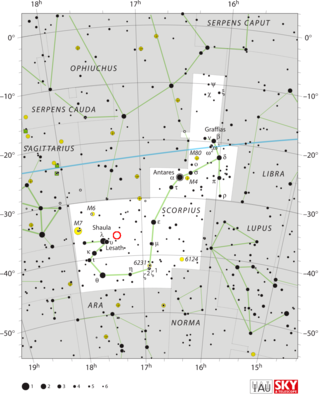
NGC 6334, colloquially known as the Cat's Paw Nebula, or Gum 64, is an emission nebula and star-forming region located in the constellation Scorpius. NGC 6334 was discovered by astronomer John Herschel in 1837, who observed it from the Cape of Good Hope in South Africa. The nebula is located in the Carina–Sagittarius Arm of the Milky Way, at a distance of approximately 5.5 kilolight-years from the Sun.

NGC 1333 is a reflection nebula located in the northern constellation Perseus, positioned next to the southern constellation border with Taurus and Aries. It was first discovered by German astronomer Eduard Schönfeld in 1855. The nebula is visible as a hazy patch in a small telescope, while a larger aperture will show a pair of dark nebulae designated Barnard 1 and Barnard 2. It is associated with a dark cloud L1450. Estimates of the distance to this nebula range from 980–1,140 ly (300–350 pc).

An astronomical catalog or catalogue is a list or tabulation of astronomical objects, typically grouped together because they share a common type, morphology, origin, means of detection, or method of discovery. The oldest and largest are star catalogues. Hundreds have been published, including general ones and special ones for such objects as infrared stars, variable stars, giant stars, multiple star systems, star clusters, and so forth.
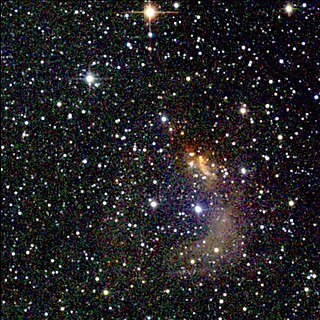
Vela Molecular Ridge is a molecular cloud complex in the constellations Vela and Puppis. Radio 12CO observations of the region showed the ridge to be composed of several clouds, each with masses 100,000–1,000,000 M☉. This cloud complex lies on the sky in the direction of the Gum Nebula (foreground) and the Carina–Sagittarius Spiral Arm (background). The most important clouds in the region are identified by the letters A, B, C and D, and in fact belong to two different complexes: the clouds A, C and D are located at an average distance of about 700-1000 parsecs and are related to the OB association Vela R2, while cloud B is located at a greater distance, up to 2000 parsecs away, and is physically connected to the extended Vela OB1 association.
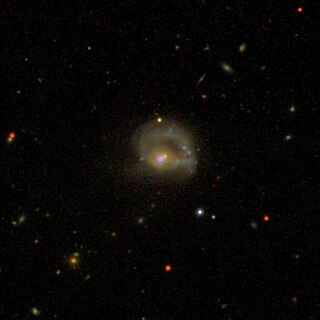
NGC 985 is a ring galaxy in the constellation of Cetus. It is located about 550 million light years away from Earth, which means, given its apparent dimensions, that NGC 985 is approximately 160,000 light years across. It was discovered by Francis Leavenworth in 1886. It is a type 1 Seyfert galaxy.

NGC 5846 is an elliptical galaxy located in the constellation Virgo. It is located at a distance of circa 90 million light years from Earth, which, given its apparent dimensions, means that NGC 5846 is about 110,000 light years across. It was discovered by William Herschel on February 24, 1786. It lies near 110 Virginis and is part of the Herschel 400 Catalogue. It is a member of the NGC 5846 Group of galaxies, itself one of the Virgo III Groups strung out to the east of the Virgo Supercluster of galaxies.
References
- ↑ Persi, P.; Ferrari-Toniolo, M. (1982). "Near-infrared sources in the NGC 6334 molecular cloud". Astronomy and Astrophysics. 112: 292. Bibcode:1982A&A...112..292P.
- ↑ Shuping, R. Y.; Morris, Mark; Bally, John (2004). "A New Mid-Infrared Map of the BN/KL Region Using the Keck Telescope". The Astronomical Journal. 128: 363. arXiv: astro-ph/0404115 . Bibcode:2004AJ....128..363S. doi:10.1086/421373.